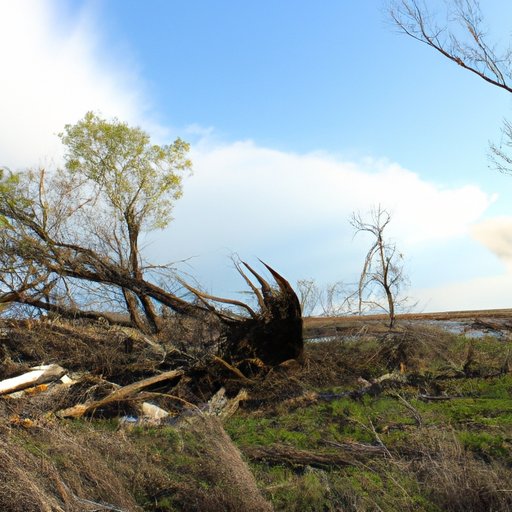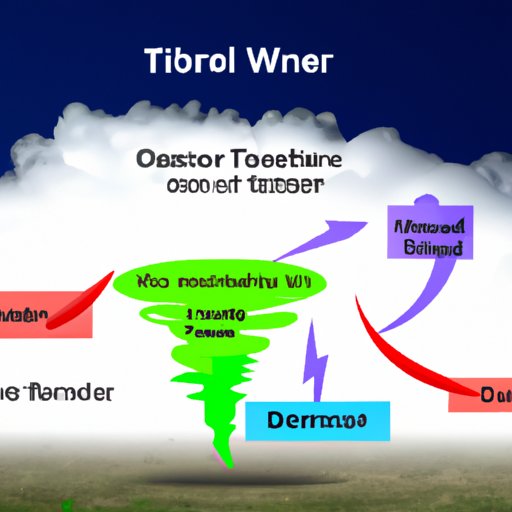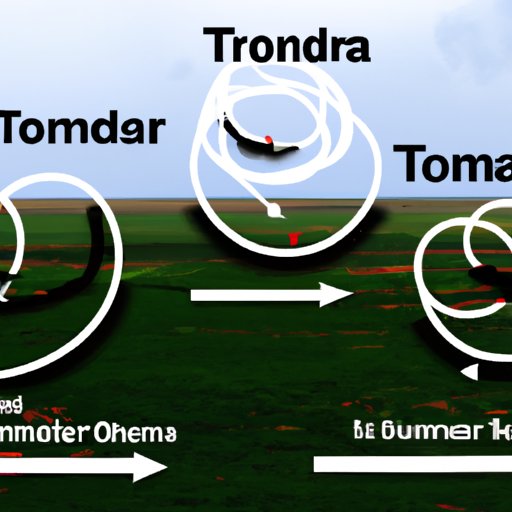Introduction
Tornadoes are some of the most powerful and destructive forces of nature. According to the National Oceanic and Atmospheric Administration (NOAA), “Tornadoes are violently rotating columns of air that extend from the base of a thunderstorm to the ground.” They can cause significant damage, including destroying buildings and uprooting trees, leading to major property damage and even loss of life. In order to better prepare for and mitigate damage caused by these storms, it is important to understand the direction in which they travel.
Exploring the Path of Destruction: Where Do Tornadoes Go?
The path of a tornado is often unpredictable, but there are certain factors that can influence the direction they take. Knowing these factors can help meteorologists better predict where a tornado is likely to go and provide people with more warning time before one strikes. Here, we explore the nature of tornado paths, the factors influencing the direction of tornadoes, and the difficulty in predicting their paths.

The Nature of Tornado Paths
Tornadoes generally move from southwest to northeast, but this is not always the case. According to research from the University of Oklahoma, “Most tornadoes have an average forward speed of 30 mph, but this can vary from nearly stationary to 70 mph.” The path of a tornado can also be curved or straight, and the length of its path varies greatly. Some tornadoes may travel only a few miles, while others can span hundreds of miles.

Factors Influencing the Direction of Tornadoes
Several factors can influence the direction of a tornado. These include the wind patterns in the atmosphere, the topography of the land, and temperature differences between the ground and atmosphere. Understanding how these factors interact can help us better predict the direction of a tornado.
Mapping the Wind: A Look at Tornado Paths
In order to better understand the direction of tornadoes, meteorologists track them using radar technology. This allows them to map the path of a tornado and determine its speed, size, and intensity. By tracking tornadoes, meteorologists can gain a better understanding of the different types of paths they take.

Different Types of Tornado Paths
There are several different types of tornado paths. Some tornadoes follow a single path, moving in a straight line until dissipating. Others follow a curved path, moving in a circular motion before dissipating. There are also multiple-vortex tornadoes, which involve two or more vortices spinning around each other. Finally, there are supercell tornadoes, which involve a single large vortex that can last for hours.
The Mystery Behind Tornado Direction
Despite our best efforts, predicting the exact direction of a tornado remains a mystery. According to meteorologist Greg Carbin, “We can make educated guesses based on current conditions, but predicting the exact path of a tornado is still impossible.” This means that people living in the path of a tornado must remain vigilant and be ready to take action if necessary.
Understanding Tornado Movement: What Determines Its Path?
Although predicting the exact path of a tornado is difficult, meteorologists can use certain factors to make educated guesses about its direction. These include wind patterns, topography, and temperature differences. By understanding how these factors interact, meteorologists can better predict the path of a tornado.
Wind Patterns
The wind patterns in the atmosphere can influence the direction of a tornado. Meteorologists look at wind speed and direction to determine the most likely path a tornado will take. For example, if the winds are blowing from west to east, the tornado is more likely to travel in an eastward direction.
Topography
The terrain of the land can also influence the direction of a tornado. Tornadoes tend to move along low-lying areas, such as valleys, rivers, and lakes. They are also more likely to move in the same direction as prevailing winds, so mountainous areas can cause tornadoes to change direction.
Temperature Differences
Finally, temperature differences between the ground and atmosphere can influence the direction of a tornado. If the air near the ground is warmer than the air higher up, the tornado is more likely to move in an upward direction. On the other hand, if the air near the ground is cooler than the air higher up, the tornado is more likely to move in a downward direction.
Following the Storm: Tracing a Tornado’s Journey
By collecting data on a tornado’s path, meteorologists can begin to piece together the puzzle and gain a better understanding of its movements. The information collected can then be used to predict the path of future tornadoes, giving people more time to prepare for the storm.
Collecting Information
Meteorologists collect data on a tornado’s path using a variety of methods, including radar, satellites, and observations from trained spotters. This information is then used to create a map of the tornado’s path, which can be used to better understand its movements.
Predicting Future Paths
By studying the data collected on a tornado’s path, meteorologists can begin to make predictions about its future movements. However, due to the unpredictable nature of tornadoes, it is impossible to accurately predict their exact path. As Carbin notes, “Tornadoes are incredibly complex and dynamic systems, and even with the best technology, it’s still impossible to predict their exact path.”
Conclusion
Tornadoes can cause significant destruction and loss of life, but understanding their paths and direction is essential in order to better prepare for and mitigate future damage. This article explored the factors that influence the direction of tornadoes, as well as the difficulty in predicting their paths. It is clear that predicting the exact path of a tornado is impossible, but meteorologists can use wind patterns, topography, and temperature differences to make educated guesses about its direction. By tracking tornadoes, meteorologists can gain a better understanding of the different types of paths they take and use this information to predict future paths.
Summary of Key Points
This article explored the factors that influence the direction of tornadoes, as well as the difficulty in predicting their paths. Tornadoes generally move from southwest to northeast, but this is not always the case. The path of a tornado can also be curved or straight, and the length of its path varies greatly. Factors that can influence the direction of a tornado include wind patterns, topography, and temperature differences. Meteorologists track tornadoes using radar technology and use this information to make educated guesses about their direction. However, predicting the exact path of a tornado is still impossible.
Final Thoughts
Tornadoes are some of the most powerful and destructive forces of nature, and understanding their paths and direction is essential in order to better prepare for and mitigate future damage. Although predicting the exact path of a tornado is difficult, meteorologists can use wind patterns, topography, and temperature differences to make educated guesses about its direction. By tracking tornadoes, meteorologists can gain a better understanding of the different types of paths they take and use this information to predict future paths.
(Note: Is this article not meeting your expectations? Do you have knowledge or insights to share? Unlock new opportunities and expand your reach by joining our authors team. Click Registration to join us and share your expertise with our readers.)
